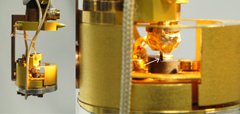Low temperature
In our low-temperature lab, temperatures of below 20 mK can be reached.

Dilution refrigerators
We are currently operating a 3He-4He dilution refrigerator with a cooling power of 50 uW at 100 mK (supplied by ICEoxford). It is installed in a liquid helium cryostat with an 8?T superconducting magnet. The system rests on its own foundation so that it is decoupled from any vibrations in the physics building.
The lab is fully prepared for a second system with a larger cooling power (200 uW at 100 mK) and an 18 T superconducting magnet (Oxford Instruments, to be installed).
Experiments
The dilution refrigerators provide the low temperatures which are necessary to study the physical properties of complex materials near their ground state. Inside, we operate self-constructed experiments to measure different thermodynamic quantities and transport properties:
Thermal Expansion and Magnetostriction
The dilatometer is a device for translating the elongation or contraction of a sample into the movement of a capacitor plate. By measuring the capacitance, we can determine length changes with a very high precision of about 0.01 Angstroems (10-12?m).


The graph shows the thermal expansion coefficient α along two different directions of a single crystal of Sr3Ru2O7. As the material enters an exotic phase below a temperature of 1 K, the measurement reveals a symmetry-breaking distortion of the crystal lattice.
?
Specific Heat and Magnetocaloric Effect
We have constructed a micro-calorimeter consisting of a thin sapphire platform with tiny heater and thermometer, which is weakly coupled to a heat bath. With this device, we can precisely detect the heat capacity and magnetocaloric effect (MCE) of very small single crystals of about 1 mg weight only. For measurements of the MCE under adiabatic conditions, we oscillate the magnetic field and detect respective oscillations of the sample temperature, as shown in the right panel.


Magnetic Susceptibility
The magnetic susceptibility dM/dH is an important property to characterize magnetic and superconducting materials. We apply a high-resolution AC technique where the sample is placed inside one coil of a pair of exactly symmetrical pick-up coils, which are placed into an alternating magnetic field. As the magnetic susceptibility of the sample changes, this results in a change of the voltage induced in the coil system, which is detected with very high resolution.


Electrical Transport
For measurements of the electrical resistance of small single crystals or thin film samples, we utilize an AC technique with low-temperature transformers and pre- and lock-in amplifiers to obtain extremely low noise levels. By this, we can detect tiny resistance changes.

The graph shows quantum oscillations in the resistivity of a thin film of CaRuO3 which is subjected to a strong magnetic field. This is the so-called Shubnikov-de Haas effect. The oscillations allow us to determine the Fermi surface and effective masses of this material.
?
Thermal Conductivity and Thermopower
Thermal conductivity and thermopower are two important transport quantities which provide important information on electronic properties of matter. For measuring the thermal conductivity, we have constructed a sample holder which is shown in the lower figure. Its main components include a heating device and thermometers to measure heat gradients. We have used the device to study the thermal conductivity for metals near quantum critical points as well as for insulating spin liquid candidate materials (see publications).


Magnetization under pressure
Magnetization measurements can be performed under hydrostatic pressure in a commercial SQUID magnetometer (MPMS). The pressure medium is Daphne oil and a small piece of lead (Pb) is used as a pressure sensor to determine the pressure inside the cell. The specifications are P <= 1.5?GPa, T = 2 - 400?K, B up to 5?T.

Gallery
Here are some more impressions from the low temperature lab:
?




